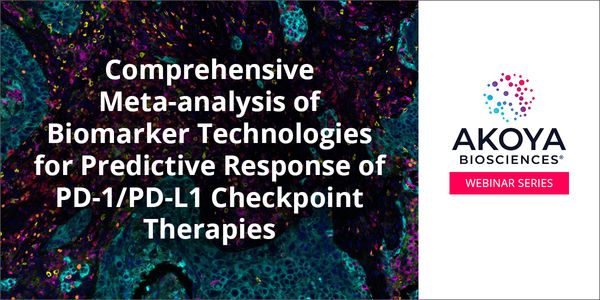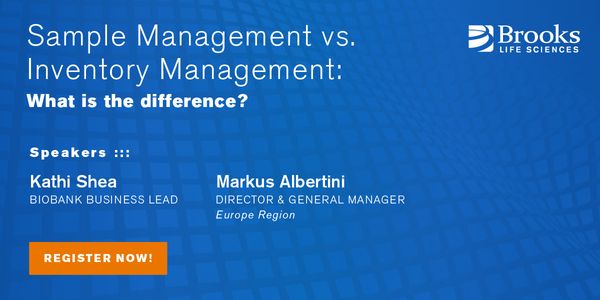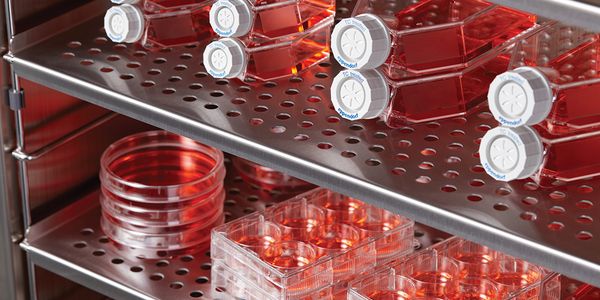Gene Expression
Gene Expression: the process by which information from a gene is used in the synthesis of a functional gene product. These products are often proteins, but in non-protein coding genes such as transfer RNA (tRNA) or small nuclear RNA (snRNA) genes, the product is a functional RNA. The process of gene expression is used by all known life-eukaryotes (including multicellular organisms), prokaryotes (bacteria and archaea), and utilized by viruses-to generate the macromolecular machinery for life.
-
AUG 27, 2019 | 9:00 AMDATE: August 27, 2019 TIME: 9:00am PDT, 12:00pm EDT Immunotherapies targeting PD-1 or PD-L1 have proven remarkably effective for treating cancer in some patients, with considerabl...AUG 22, 2019 | 10:30 AMDNA profiling tools to teach undergraduate students about forensics generally utilize the PV92 Alu and D1S80 VNTR markers, but are both limited in scope. In contrast, advanced profiling syste...AUG 22, 2019 | 9:00 AMContemporary law enforcement has greatly expanded its ability to solve crimes by the adoption of advanced forensic techniques, electronic monitoring and new approaches in crime scene procedur...AUG 22, 2019 | 7:30 AMThe incidence of conditions such as diabetes, obesity, asthma, and cancer have increased substantially in the past 30 years. The human genome has not changed in that period of time, so the en...AUG 22, 2019 | 6:00 AMPrediction of human response to chemical exposures is the primary challenge of pharmaceutical and environmental toxicology research. The complexity of human responses to xenobiotic exposures...JUL 23, 2019 | 10:00 AMDATE: July 23, 2019TIME: 10:00am PDTThe tumor microenvironment is a complex network of different cell types and states that imparts distinct properties to the tumor and plays a signif...Speaker: Doug Hinerfeld, PhD , Chris Merritt, PhD , Anushka Dikshit, PhDSponsored By: Advanced Cell DiagnosticsJUN 26, 2019 | 9:00 AMDATE: June 26, 2019TIME: 9:00am PDT, 12:00pm EDT An excessive number of software solutions are available to help manage your clinical, biobank, or biorepository sample inform...JUN 19, 2019 | 10:00 AMDATE: June 19, 2019TIME: 10:00am PDT, 1:00pm EDT As we develop new methods to create more biologically relevant models for research in understanding disease etiology and in...JUN 05, 2019 | 5:00 PMDATE: June 5, 2019TIME: 8:00am PDT, 11:00am EDT, 5:00pm CEST Eukaryotic cell cultures respond to the most subtle influence. Apart from the risk of contamination, minimal chan...MAY 23, 2019 | 9:00 AMDATE: May 23, 2019TIME: 9:00am PDT, 12:00pm EDT Although mesenchymal stem/stromal cells (MSCs) chondrogenic differentiation has been thoroughly investigated...MAY 16, 2019 | 4:00 PMDATE: May 16, 2019TIME: 7:00am PDT, 10:00am EDT, 4:00pm CEST The emergence of NGS is revolutionizing the microbiological sciences and transforming medicine. Deep sequencing has...MAY 09, 2019 | 1:30 PMC.E. CREDITSIn 2014, the Undiagnosed Diseases Network (UDN), which is funded by the NIH, was established as a network of seven clinical sites, two sequencing cores, and a coordinating center. Later, a ce...MAY 09, 2019 | 12:00 PMScreening to identify all known viruses and other pathogenic microorganisms including bacteria, fungus and parasites in human tumor tissues will provide a more comprehensive understanding of...Speaker: Erle Robertson, PhDMAY 09, 2019 | 10:30 AMReal-time PCR, or quantitative qPCR, is a commonly used molecular biology lab technique to determine the actual amount of PCR product at a given cycle. For quantitative reverse transcription...Speaker: Gillian Browne, PhDMAY 09, 2019 | 10:30 AMSpeculations that some form DNA alteration might be utilized by the brain date to the 1960s [1] wherein hypotheses for genomic alterations of germline DNA were proposed for immunoglobulins an...MAY 09, 2019 | 9:00 AMThe advent of precision medicine largely depends on the creation of precise and accurate predictive tools. While most late-onset diseases are moderately to highly heritable, using genetic inf...Speaker: Guillaume Paré, MD, MSc, FRCPCMAY 09, 2019 | 9:00 AMRelease of the first human genome assembly was a landmark achievement, and after nearly two decades of improvements, the current human reference genome (GRCh38) is the most accurate and compl...MAY 09, 2019 | 7:30 AMC.E. CREDITSRecent technological advances as well as longitudinal monitoring not only have the potential to improve the treatment of disease (Precision Medicine) but also empower people to stay healthy (...MAY 09, 2019 | 6:00 AMVariant interpretation presents a bottleneck for many labs, posing a challenge to the broader adoption of precision medicine. The ACMG/AMP variant classification framework has provided a foun...MAY 08, 2019 | 1:30 PMRecent improvements in sequencing chemistry and instrument performance combine to create a new PacBio data type of highly accurate (HiFi), long insert reads. Increased read length and improve...Speaker: Jonas Korlach, PhDMAY 08, 2019 | 12:00 PMNext-generation transcriptome and miRNome sequencing are routinely performed on traditional cell or tissue samples, as well as more difficult samples such as FFPE samples and biofluids. Regar...Speaker: Jonathan Shaffer, PhD, MBAMAY 08, 2019 | 10:30 AMC.E. CREDITSOne of the central tenants of biology is that our genetics—our genotype—influences the physical characteristics we manifest—our phenotype. But with more than 25,000 human ge...MAY 08, 2019 | 10:30 AMThe last two decades have seen an explosion in the volume of oncology data generated using next-generation sequencing (NGS) and multi-omics techniques. As a result, there is a growing need fo...Speaker: Devendra Mistry, PhDMAY 08, 2019 | 9:00 AMArrayed gene knockout (KO) libraries represent a valuable resource for performing functional genomics screening. Current generation arrayed KO libraries for the whole human genome rely on eit...Speaker: Kevin Holden, PhD
AUG 27, 2019 | 9:00 AM
DATE: August 27, 2019 TIME: 9:00am PDT, 12:00pm EDT Immunotherapies targeting PD-1 or PD-L1 have proven remarkably effective for treating cancer in some patients, with considerabl...
AUG 22, 2019 | 10:30 AM
DNA profiling tools to teach undergraduate students about forensics generally utilize the PV92 Alu and D1S80 VNTR markers, but are both limited in scope. In contrast, advanced profiling syste...
AUG 22, 2019 | 9:00 AM
Contemporary law enforcement has greatly expanded its ability to solve crimes by the adoption of advanced forensic techniques, electronic monitoring and new approaches in crime scene procedur...
AUG 22, 2019 | 7:30 AM
The incidence of conditions such as diabetes, obesity, asthma, and cancer have increased substantially in the past 30 years. The human genome has not changed in that period of time, so the en...
AUG 22, 2019 | 6:00 AM
Prediction of human response to chemical exposures is the primary challenge of pharmaceutical and environmental toxicology research. The complexity of human responses to xenobiotic exposures...
JUL 23, 2019 | 10:00 AM
DATE: July 23, 2019TIME: 10:00am PDTThe tumor microenvironment is a complex network of different cell types and states that imparts distinct properties to the tumor and plays a signif...
Speaker:
Doug Hinerfeld, PhD
, Chris Merritt, PhD
, Anushka Dikshit, PhD
Sponsored By: Advanced Cell Diagnostics
JUN 26, 2019 | 9:00 AM
DATE: June 26, 2019TIME: 9:00am PDT, 12:00pm EDT An excessive number of software solutions are available to help manage your clinical, biobank, or biorepository sample inform...
JUN 19, 2019 | 10:00 AM
DATE: June 19, 2019TIME: 10:00am PDT, 1:00pm EDT As we develop new methods to create more biologically relevant models for research in understanding disease etiology and in...
JUN 05, 2019 | 5:00 PM
DATE: June 5, 2019TIME: 8:00am PDT, 11:00am EDT, 5:00pm CEST Eukaryotic cell cultures respond to the most subtle influence. Apart from the risk of contamination, minimal chan...
MAY 23, 2019 | 9:00 AM
DATE: May 23, 2019TIME: 9:00am PDT, 12:00pm EDT Although mesenchymal stem/stromal cells (MSCs) chondrogenic differentiation has been thoroughly investigated...
MAY 16, 2019 | 4:00 PM
DATE: May 16, 2019TIME: 7:00am PDT, 10:00am EDT, 4:00pm CEST The emergence of NGS is revolutionizing the microbiological sciences and transforming medicine. Deep sequencing has...
MAY 09, 2019 | 1:30 PM
C.E. CREDITS
In 2014, the Undiagnosed Diseases Network (UDN), which is funded by the NIH, was established as a network of seven clinical sites, two sequencing cores, and a coordinating center. Later, a ce...
MAY 09, 2019 | 12:00 PM
Screening to identify all known viruses and other pathogenic microorganisms including bacteria, fungus and parasites in human tumor tissues will provide a more comprehensive understanding of...
Speaker:
Erle Robertson, PhD
MAY 09, 2019 | 10:30 AM
Real-time PCR, or quantitative qPCR, is a commonly used molecular biology lab technique to determine the actual amount of PCR product at a given cycle. For quantitative reverse transcription...
Speaker:
Gillian Browne, PhD
MAY 09, 2019 | 10:30 AM
Speculations that some form DNA alteration might be utilized by the brain date to the 1960s [1] wherein hypotheses for genomic alterations of germline DNA were proposed for immunoglobulins an...
MAY 09, 2019 | 9:00 AM
The advent of precision medicine largely depends on the creation of precise and accurate predictive tools. While most late-onset diseases are moderately to highly heritable, using genetic inf...
Speaker:
Guillaume Paré, MD, MSc, FRCPC
MAY 09, 2019 | 9:00 AM
Release of the first human genome assembly was a landmark achievement, and after nearly two decades of improvements, the current human reference genome (GRCh38) is the most accurate and compl...
MAY 09, 2019 | 7:30 AM
C.E. CREDITS
Recent technological advances as well as longitudinal monitoring not only have the potential to improve the treatment of disease (Precision Medicine) but also empower people to stay healthy (...
MAY 09, 2019 | 6:00 AM
Variant interpretation presents a bottleneck for many labs, posing a challenge to the broader adoption of precision medicine. The ACMG/AMP variant classification framework has provided a foun...
MAY 08, 2019 | 1:30 PM
Recent improvements in sequencing chemistry and instrument performance combine to create a new PacBio data type of highly accurate (HiFi), long insert reads. Increased read length and improve...
Speaker:
Jonas Korlach, PhD
MAY 08, 2019 | 12:00 PM
Next-generation transcriptome and miRNome sequencing are routinely performed on traditional cell or tissue samples, as well as more difficult samples such as FFPE samples and biofluids. Regar...
Speaker:
Jonathan Shaffer, PhD, MBA
MAY 08, 2019 | 10:30 AM
C.E. CREDITS
One of the central tenants of biology is that our genetics—our genotype—influences the physical characteristics we manifest—our phenotype. But with more than 25,000 human ge...
MAY 08, 2019 | 10:30 AM
The last two decades have seen an explosion in the volume of oncology data generated using next-generation sequencing (NGS) and multi-omics techniques. As a result, there is a growing need fo...
Speaker:
Devendra Mistry, PhD
MAY 08, 2019 | 9:00 AM
Arrayed gene knockout (KO) libraries represent a valuable resource for performing functional genomics screening. Current generation arrayed KO libraries for the whole human genome rely on eit...
Speaker:
Kevin Holden, PhD
























